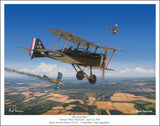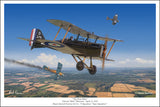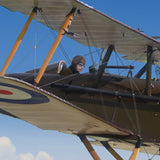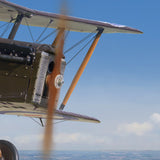Edward "Mick" Mannock was a legendary pilot who served in the Royal Flying Corps and Royal Air Force during the First World War. He had a reputation for being aggressive in aerial combat with cold-blooded nerve and determination as well as being an inspirational leader. He was one of the greatest aces of the war ranking fifth overall with an official tally of 61 aerial victories although some claim that there are many more uncredited victories.
Edward Mannock had a rough upbringing. His father abandoned the family and left them penniless. Young Edward was forced to work at menial jobs to help the family. Eventually he found work with the National Telephone Company. Advancing through several positions in that field, he was working as a telephone engineer for the Ottoman Telephone Exchange in Turkey when the war broke out in 1914. He was interned in a Turkish prison. Poorly treated and near death, he was released after 6 months to return to England.
He joined the military first with the Royal Army Medical Corps and then transferred to the Royal Engineers as an officer cadet. Eventually he joined the Royal Flying Corps as a second lieutenant. He quickly exhibited a natural making his first solo flight after only a few hours instruction; quickly mastering the rudiments of flying and from then on maneuvering the airplane through the air as he pleased.
Arriving in France on 31 March 1917, Mannock had a slow start. Initially nervous and unsure about combat, his first days were rocky. With determination and improving flying skills, his confidence improved and he soon became an ace having downed 5 enemy craft.
In February of 1918, Mick joined 74 Squadron as a captain. The squadron began to convert to the Royal Aircraft Factory S.E.5 fighter. The airplane was powerful with a 200 horsepower Hispano-Suiza 8 engine. It carried two guns, a .303 caliber Lewis gun mounted on the top wing and a Vickers machine gun mounted on top of the fuselage over the engine and its cowling. In February of 1918 he was made senior flight commander and in March 74 Squadron was sent to France equipped with the S.E.5 fighters.
Mick went on to great success leading A Flight and was awarded the Distinguished Service Order on 9 May 1918. He went on to further success as commander of 85 Squadron, joining on July 5 of 1918. He was tragically killed in action on July 26 after shooting down an enemy LVG two-seater behind the German front-line having have dived low to the crash site to view the wreckage. It is believed he may have fallen victim to gunfire from the ground however the exact cause of his death remains uncertain. He has no known grave.
This artwork is a depiction of Mick Mannock flying S.E.5a S/N D278 in combat on April 12 of 1918. He downed two Albatros D.V aircraft that day.








